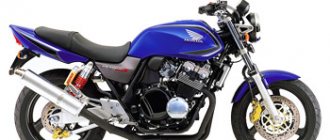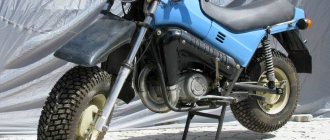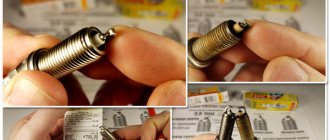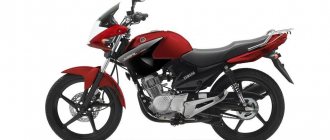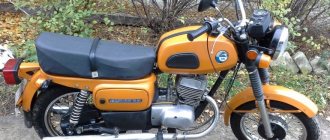What is meant by a classic moped?
According to Russian traffic regulations, a moped is understood as a three- or two-wheeled transport vehicle on which a small engine is installed. The speed it develops is up to fifty kilometers per hour . This is usually a 50 cm3 engine (definitions may vary in other countries). Unlike motorcycles, mopeds do not require registration, insurance, technical inspection, or a driving license. Due to their low speed, they, like bicycles, should move closer to the right side of the road.
The classic type of mopeds is a bicycle drive (pedal), a chain drive to the rear wheel, a freewheel, a brake that is activated when the pedals are rotated in the opposite direction (like a bicycle). The rear wheel also has a driven sprocket for the motor chain drive (rigid, without a freewheel).
Classic moped with pedals
The drive sprocket is located with the engine on the same shaft or (sometimes) separated from the latter by a friction clutch (clutch). To disengage the clutch there is a special lever on the left handlebar. There is no gearbox, but sometimes a gearbox is installed. Rotating the throttle on the right handlebar controls the carburetor valve (throttle). The front brake lever is also located there.
The feasibility of installing HBO
The question may arise about the advisability of installing a gas cylinder system on a motorcycle or scooter, because modern scooters already have fairly low gas mileage. When consuming 2-2.5, maximum 3 liters of gasoline per hundred, is it worth incurring significant costs and installing gas equipment? The answer is clear - it’s worth it, for those who want to modernize their two-wheeled friend.
A drop in power and an increase in fuel consumption is one of the negative aspects of a gas-cylinder installation
However, for those who travel little and use a scooter only as weekend transport, the costs will not pay off very quickly. At the same time, if you need to travel long distances to work every day, such a modification will allow you to save significantly.
One of the negative aspects is a drop in power and increased fuel consumption. When the engine runs on gasoline, it enters the engine in a liquid consistency, occupying a reduced volume compared to gas.
A smaller amount of gas entering the engine cylinder through the carburetor or injector causes a drop in thrust. The engine needs more gas fuel, which causes an increase in its consumption by 8-10% compared to gasoline.
Finding a place for a gas cylinder is also a serious problem. The volume of the seat box, in which a helmet is usually stored, does not always allow for a gas cylinder to be placed. It is not possible to equip a moped or motorcycle with a standard car cylinder. Today, small-sized fuel tanks for gas with a volume of about six liters are offered. The volume of the rear case, which will have to be additionally equipped with the motorcycle, will allow you to accommodate a six-liter container.
It is necessary to dwell separately on the design features of the scooter, which is planned to be equipped with gas equipment. For such a modification, the moped must be equipped with a four-stroke engine and be able to start with a kickstarter. There is a high probability that using the electric starter for a long time when starting the engine on gas will drain the battery much faster.
Finding a place for a gas cylinder is a serious problem
As you can see, converting a scooter, moped or motorcycle to gas has not only positive aspects, but also negative aspects. However, this does not stop tuning lovers. They have to independently equip their motorcycles with a cylinder, install gas lines and install dosing equipment, since there are no specialized service centers involved in gasification of mopeds and scooters.
Gas moped
A moped, due to the absence of gear shifting, in which the speed is controlled only by the “gas” handle, is called a gas moped. Another name for them is motorbike , although the name comes from “motorcycle” and “bicycle” (pedal). The designs of mopeds produced today are much more complex.
Despite the presence of pedals, it is almost impossible to ride mopeds without a motor. The design is much heavier than a traditional bicycle, and the low seat is suitable for motorized riding only.
Video: Original gas moped
How to install HBO on a motorcycle or scooter?
If possible difficulties do not bother the owners of motor vehicles, it is worth understanding in detail the issues of installing gas equipment on a two-wheeled vehicle. Due to the fact that specialized centers do not carry out such work, you will have to convert the moped to gas yourself. Let's figure out what is included in the gas equipment kit for a motorcycle and how installation is carried out. Let us also dwell on the features of the functioning of the gas cylinder system.
Gas moped - elements of a gas installation
For tuning, you need to prepare a set of equipment, including the following parts:
- a gas cylinder with a capacity of at least 6 liters, the dimensions of which correspond to the free space on a moped or motorcycle;
- a set of fittings for connecting to the intake manifold, gearbox and connecting lines with coolant;
- a reducer designed to reduce the pressure of liquefied gas and convert it into a gaseous state;
- a control unit that has a built-in chip, the firmware of which provides control commands when the engine is running on gas;
- pressure and temperature control sensors with electrical wires equipped with connecting connectors;
- a collapsible liquefied gas filter that cleans the fuel from foreign impurities and allows you to replace the cartridge.
A set of equipment must be prepared for tuning a moped with a gas installation.
You will also need a button with which you can forcibly turn the gas on and off. The equipment set includes adjustment elements, a safety valve, a ramp and a number of other parts indicated on the typical connection diagram for a gas cylinder installation.
Installation
Having prepared everything necessary, they begin installation work in accordance with the chosen scheme. Before you start tuning, you should clearly determine where the elements of the gas cylinder installation will be located, how the lines will be laid to ensure their safe operation and maintenance.
First, you need to securely secure the gas cylinder in the case or seat box and connect the injector emulator to the scooter control unit. Then you should place a gas supply button on the dashboard. The further procedure involves connecting sensors, connecting supply lines to the gearbox, nozzles and cylinder, as well as connecting lines with coolant to the gearbox.
The connection of the control unit is carried out in strict accordance with the previously prepared circuit diagram of the electrical equipment. It is advisable to use wires of different colors to avoid installation errors and to correctly connect all electrical equipment. After completing the installation operations, it is necessary to check the tightness of the fuel lines and make sure that the controller and emulator are connected correctly.
You can do the installation of a gas installation on a scooter yourself
Leakage control is carried out by spraying a soap solution onto the fittings connecting the fuel pipes to the injectors, gearbox, ramp and gas cylinder. If bubbles form, it is necessary to tighten the fittings more tightly to prevent leaks of liquefied gas.
Gas motorcycle - operating principle
The operation of the gas cylinder installation is quite simple. When a control signal is applied to the multivalve of a gas cylinder, propane-butane under pressure enters the reducer through the intermediate valve.
The transformation of liquefied fuel into a gaseous state occurs as a result of heating of the gearbox by the liquid circulating in the cooling system. The reducer regulates the pressure of gaseous fuel directed to the injectors in proportion to the vacuum in the intake manifold.
Information from the temperature sensor and gas pressure sensor built into the manifold is sent to the controller, which also processes information about the crankshaft speed. Working in tandem with the scooter's control unit, the controller decides whether to turn on gasoline or gas injectors and their operating modes.
If the engine does not heat up enough during start-up, the control system turns on the supply of gasoline to warm up the engine. Once the operating temperature is reached, it automatically switches to gas. After the reducer, the gas flows through pipelines to a ramp on which electromagnetically controlled injectors are mounted. The volume of gas entering the combustion chamber depends on the cross-section of the outlet fittings. Depending on the engine cubic capacity, the channel diameter should be 1-1.5 mm.
For long mileage, it is advantageous to equip motorcycles with gas equipment.
An engine with an injection power system needs one more component - an emulator. It is included in the system in parallel with the injectors. When switching from gasoline to gaseous fuel, the gasoline injectors are switched off. However, the emulator simulates their functioning so that the control unit does not turn off the power system.
pros
Another advantage is that gas is slightly cheaper than traditional fuel - gasoline. In addition, gasoline poses a risk of inhaling harmful substances contained in it, such as ferocene or tetraethyl lead, the inhalation of which leads to dire consequences.
These representatives of the chemical industry are absent from gas, just as tar deposits are not formed during its combustion. This can be judged by the color of the engine oil, which remains almost unchanged. When running on gasoline, it turns black.
Pros and cons of using gas
When planning to convert your scooter, moped or motorcycle, for example MT, to gas fuel, you should understand what advantages a gas-cylinder installation provides, as well as analyze possible disadvantages. The octane number increased compared to gasoline and the absence of harmful additives in the gas ensure stable and long-term engine operation. Let us dwell on the feasibility of converting a two-wheeled vehicle to gas.
LPG installation on a scooter has its pros and cons
Main advantages:
- significant reduction in fuel purchase costs. Cost-effectiveness is the main advantage of converting a moped. After all, the cost of gas is more than two times lower than the price of gasoline with a small difference in fuel consumption;
- improving the smooth operation of the power unit. Longer combustion of the propane-butane mixture in the cylinder reduces the forces in the cylinder-piston group and on the crankshaft. The motor is quieter and more stable;
- a significant increase in the operating life of the internal combustion engine. Operation of the main engine parts under less loaded conditions allows valves, pistons, spark plugs and liners to operate much longer;
- increase in power reserve. The presence of a gas cylinder installation on a scooter does not exclude the possibility of using gasoline. The controller will immediately switch the engine to another type of fuel, which will allow you to cover 2 times the distance;
- reduction of emissions of harmful substances. The gas does not contain toxic tetraethyl lead, which is found in gasoline. Converting a carburetor or injection engine to gas fuel will allow it to comply with Euro 1 or even Euro 3 requirements.
In addition, there are no tar deposits on the spark plugs, which ensures a normal spark and promotes efficient fuel combustion. After driving on gas, pay attention to the color of the engine oil. When running on gasoline, it takes on a pitch-black hue, but on gas, the color practically does not change. It should be noted that the pores in the catalyst do not coke, which allows it to be used on gas scooters for much longer.
LPG installation on a scooter incurs additional costs for the owner
Other advantages include quieter engine operation and a smooth ride. The engine is less noisy and responds more gently to turning the throttle, without losing throttle response. The absence of smoke from the exhaust indicates normal combustion of the fuel and the absence of heavy fractions in it.
The owner of a scooter or moped who decides to convert his motorcycle will have to face a number of problems. After all, a gas cylinder installation has not only advantages, but also disadvantages.
Main disadvantages:
- additional costs associated with the need to purchase gas equipment and its installation;
- the need to select a free space that allows you to place a fuel cylinder with liquefied gas.
In addition, it is quite possible that the owner of a moped or motorcycle will have to face questions related to the legalization of the installation of gas equipment. Indeed, during a technical inspection or when stopping a vehicle, questions may arise about the legality of the conversion and the availability of relevant documents.
